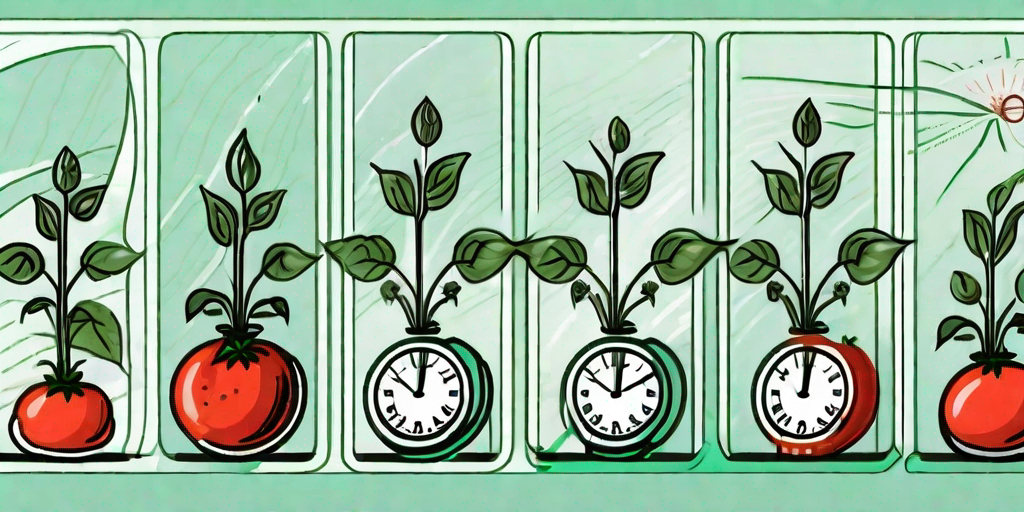
The world of gardening is a fascinating one, filled with the thrill of watching life sprout from a tiny seed, the anticipation of the first fruits, and the satisfaction of a bountiful harvest. But, as any seasoned gardener will tell you, it's not all sunshine and roses. There are challenges to be faced, decisions to be made, and timing to be considered. One such critical timing decision is when to transplant your tomato seedlings. Get it wrong, and you could be singing a tomato-less blues song all summer long. But get it right, and you'll be the tomato king or queen of your neighborhood. So, let's dive into the juicy details of tomato transplanting timing.
Understanding the Life Cycle of a Tomato Plant
From Seed to Seedling
Tomato plants start their life as a humble seed. Once planted, they germinate and sprout into a tiny seedling. This process usually takes about 6-8 weeks, depending on the variety and the growing conditions. During this time, the seedlings are delicate and need careful attention to ensure they grow strong and healthy.
It's essential to provide the right amount of light, water, and nutrients. Too little light, and the seedlings will become leggy and weak. Too much water, and they might succumb to damping off, a fungal disease that can kill young seedlings. And without the right nutrients, they won't grow as they should.
From Seedling to Mature Plant
Once the seedlings have developed their first set of true leaves (those are the ones that look like actual tomato leaves, not the initial seed leaves), they're ready to start their journey towards becoming a mature plant. This is where the timing of transplanting comes into play.
Transplanting is the process of moving a plant from one location to another. For tomato seedlings, this usually means moving them from their initial seed tray or pot into a larger pot or directly into the garden. The goal is to give the plants more room to grow and access to the nutrients they need to thrive.
The Perfect Timing for Transplanting Tomato Seedlings
Looking for the Signs
So, when is the best time to transplant your tomato seedlings? Well, the plants themselves will give you a hint. As mentioned earlier, once the seedlings have developed their first set of true leaves, they're ready for transplanting. But there's more to it than that.
You also need to consider the size of the seedlings. They should be about 3-4 inches tall before you transplant them. Any smaller, and they might not be strong enough to survive the move. Any larger, and they might become root-bound, which can stunt their growth.
Considering the Weather
Another critical factor in determining the best time to transplant tomato seedlings is the weather. Tomatoes are warm-weather plants, which means they don't like cold temperatures. If you're transplanting them directly into the garden, you need to wait until the danger of frost has passed.
But it's not just the cold that can harm your tomato plants. They also don't like extreme heat. So, if you live in an area with scorching summers, you might want to transplant your seedlings in the late afternoon or early evening when the temperatures are cooler.
How to Transplant Tomato Seedlings
Preparing the New Home
Before you transplant your tomato seedlings, you need to prepare their new home. If you're moving them into a larger pot, make sure the pot is clean and has good drainage. Fill it with a high-quality potting mix, leaving some space at the top for the seedling.
If you're transplanting the seedlings directly into the garden, choose a sunny spot with well-drained soil. Dig a hole that's deep enough to cover the stem up to the first set of true leaves. This encourages the plant to develop a strong root system.
Moving Day
When it's time to transplant, water the seedlings well. This makes it easier to remove them from their current pot without damaging the roots. Gently lift the seedling, taking care not to pull on the stem or leaves.
Place the seedling in the new pot or garden hole, making sure the stem is covered up to the first set of true leaves. Fill in with soil, firming it gently around the base of the plant. Water well, and voila, your tomato seedlings have a new home!
FAQs
- Can I transplant tomato seedlings more than once?
Yes, you can. Some gardeners prefer to transplant their seedlings into a larger pot before moving them into the garden. This gives the plants more time to develop a strong root system.
- What if my seedlings are leggy?
Leggy seedlings have stretched out in search of light, resulting in a long, thin stem. You can help these seedlings by burying the stem up to the first set of true leaves when you transplant them. This encourages the plant to develop roots along the stem, leading to a stronger plant.
- Can I transplant tomato seedlings in the rain?
It's best to avoid transplanting in the rain, as the wet conditions can lead to the spread of diseases. However, a light drizzle can be beneficial, as it provides the plants with a good watering.
There you have it, folks! The ins and outs of transplanting your tomato seedlings. Remember, timing is everything. Pay attention to your plants, consider the weather, and prepare the new home properly, and you'll be well on your way to a bumper crop of delicious tomatoes. Happy gardening!











